How the Germans stormed the Moonsund Islands
Landing in the Gulf of Taga
The Germans began the operation with aviation training. On the night of September 24-25, 1917, three airships dropped about 5700 kg of bombs on batteries in Tserel. On the evening of October 1, the Salis (Salasgriva) area was bombarded. The Germans dropped 8 tons of bombs on the port and the roads leading to it. On October 1, 5, 9 and 10, Russian batteries were bombed on Tserel, in Pernov and Ainazi, causing quite serious damage.
On October 10 (September 28 according to the old style) of 1917, the Albion operation itself began. The first group of invasion ships left Libava, consisting of the 1st and 2nd half-fleets of minesweepers, 4 destroyers and many auxiliary vessels. This group was supposed to pave the way for battleships and transports to the landing site. The next day, at 9 a.m., the second group of invasion ships left the Libava as part of the 30nd flotilla minesweepers, the 8th semi-flotilla of minesweepers, the 2nd flotilla of destroyers and 3 transports. Onboard the ships of the 2nd flotilla of destroyers and on transports, paratroopers of the forward detachment were found. The third group included the main forces of the fleet: the 3rd and 4th battalion squadrons, the Moltke battlecruiser, and the Emden light cruiser. From a possible attack by submarines, ships were guarded by destroyers of the 6th flotilla, the 13th and 15th half-fleets. The fourth group consisted of transports that covered the cruisers of the 2nd reconnaissance group.
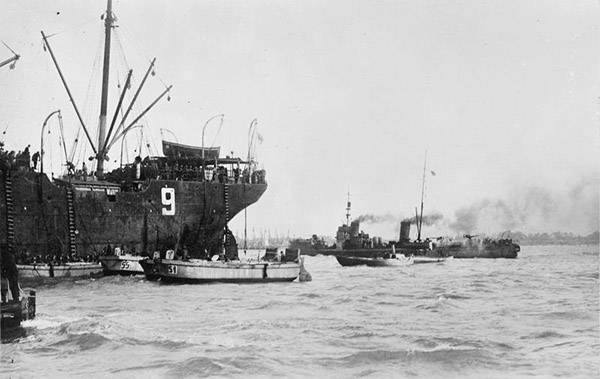
The first three groups, focusing and taking order of battle, in 9 hours 15 min. am 11 october headed north. The next day, in the morning hours of 3, the battleships of the 3 squadron, together with the destroyers of the 2 fleet, were on a raid in Taga Bay. More than 1 thousand soldiers in motor boats moved to the shore. Behind them, without waiting for the late minesweepers of the 2 fleet, and risking to run into mines, transports of Corsica, Equity and Blitz, which were still more than 2 thousand soldiers, moved into the bay. Germans are lucky. On the mine, only the Corsica was blown up, and the victims were avoided. The nearby destroyers quickly took the soldiers from the transport to their aboard.
Landing is already in 5 hours 30 min. was on the shore. Three minutes before the battleships Kaiser, Prince Regent Luitpold and Kaiserin opened fire on the Russian battery on the west bank, and the battleships of the 3 squadron on the battery on the east bank. The fire of ship artillery was so powerful that the Russian batteries, after carrying out several volleys, fell silent. For half an hour, the Russian coastal defense was completely suppressed, and the landing force landed quietly. During the firing of the battleship "Grosser Kurfyurst" blew a mine, but did not leave the battle. It was only after noon that he began to move to Wilhelmshaven. The damage was minor and 18 November, the ship returned to service.
6 hours 45 min. transports with the second echelon of the landing force entered the bay. Only one Russian field battery bravely tried to stop his landing. The German infantry stormed the position. Since that time, no one opposed the landing. Almost at the same time, the battleships of the Friedrich der Grosse and König Albert squadrons of the 4 squadron, along with the destroyers of the 15 flotilla and the minesweepers, began according to plan a diversion operation, shelling the Svorbe peninsula. And the destroyers of the 3 semi-fleet fired at Russian airfields at Papensholm and Kilconde (Kihelkona).
Kassar
From the beginning of the landing operation, supremacy in Soalosund and on the Kassar Reservoir was of paramount importance both for the Germans and the Russians. In the case of the capture of Soelozund by the Germans, the Russians would not have been able to transfer their destroyers to the landing area of the enemy troops through Kassar Bay. This envisaged a Russian defense plan. However, the bay's defense was very weak: one battery of 4 X-guns of caliber 120 mm at Cape Tofri (Dago Island). Therefore, the Germans quickly succeeded.
During the operation in Soalosund, the Germans used the battleship Bayern and the cruiser Emden. The battleship, advancing to the firing position, was shaken by a strong explosion. The signalmen, unable to withstand the nervous tension, immediately reported on the periscope of the submarine. The battleship's mine artillery opened heavy fire at an unknown enemy. In fact, Bayern was not hit by a submarine: the battleship hit a Russian minefield set up on 12 on August 1917, from the minzag Pripyat and minesweepers Gruz and No. 15. The Russian anchor shock-proof mine of the 1908 model of the year struck the battleship in the area of the nose compartment of the onboard torpedo tubes, which was outside the main contour of the underwater protection - in the most unfortunate place for the ship. The explosion of a mine provoked an explosion of twelve compressed air cylinders. As a result, not only the compartment of the onboard torpedo tubes, but also the nose torpedo tube compartment was flooded. The ship took over 1000 tons of seawater and quickly began to sink into the water. However, an effective trimming system made it possible to quickly take water into the feed compartments and the ship’s screws remained under water. The transverse bulkhead separating the front compartment of the TA from the cellar of the ammunition ammunition, withstood the pressure of the water, allowing localization of the flooding of the hull. Therefore, the battleship decided to continue the execution of the combat mission.
In 6 hours of the morning, German ships approached the 20 cable distance to Cape Toffrey, after which Russian battery No. 34 opened fire on them, hitting the destroyer A-28. The Bayern and the light cruiser Emden opened fire on the battery, crushing it. On 7, the landing began. Not meeting resistance, the Germans moved to Orissaru. As soon as the Russian battery on Cape Tofri was silent, the Germans entered Kassar Bay and began trawling. Suddenly the Russian battery spoke again. Her calculation, after the completion of the shelling, returned to the guns. "Bayer" again opened fire from heavy guns and put down the battery. Then the destroyers landed troops at the Russian battery and the Germans blew up the guns.
Admiral Bakhirev found out about the enemy’s landing on the morning of October 12 and sent the destroyers “General Kondratenko” and “Border Guard” to clarify the situation in the Soelozund area. In the afternoon they met the German destroyer and the 3 minesweeper. Those moved under the cover of "Emden". 15 hours 30 min. five German destroyers entered Kassar Bay. By this time, the Russian forces in the Gulf had been increased by the cannon “The Terrible” and the destroyer “Desna” under the flag of Rear Admiral GK Stark. Then came the destroyers "Izyaslav", "Thunder", "Bully", "Samson" and "Novik". German and Russian destroyers fired at each other. At night, the Russian ships went to Moonzund, the Germans also retreated to the main forces.
October 13 Russian destroyers conducted reconnaissance in Soelosund. The cruiser "Emden" fired at them and forced them to retreat. All day, the Germans conducted trawling and reconnaissance in Soelozund and Kassar. On the morning of October 14, the 2-I flotilla of German destroyers, as well as the 12-I and semi-flotilla 13, entered Soelosund to occupy the eastern entrance to it and to Kassar. The offensive was launched with the support of the heavy artillery of the battleship “Bayern” and the guns of “Emden”. Both of these ships could not enter either the strait or the bay, since there it was too small for them. "Kaiser" seriously damaged the Russian destroyer "Thunder", he lost his turn. This was used by German destroyers, who began to fire at a fixed Russian ship. Gunbot "Brave" tried under enemy fire to move a towline, but failed. The Germans landed on the Russian destroyer, but when they tried to tow it to the shore, the Thunder sank. The Russian ships retreated to Moonsund. Thus, the Germans occupied Soelozund and Kassar Reach. The left flank of the German airborne corps was securely covered.
Meanwhile, German troops developed an offensive on Ezel. Russian troops retreated to Orissaru and the Svorbe peninsula. October 12 fell Ahrensburg, where previously the Russian destroyed all military facilities and warehouses. The German fleet was ordered to subject the Tserel peninsula to heavy fire. This task was performed by the battleships Friedrich der Grosse, König Albert, and Kaiserin with 6 destroyers. Simultaneously with the ship bombardment, Russian positions on the 14 peninsula of October were attacked by German infantry. The resistance was weak and the next day the German troops took the peninsula. The two batteries on Tserele (120-mm and 130-mm guns) became their trophies. The Russians managed to disable the battery of 305-mm guns.
October 15 Germans forces 2-th flotilla and 13-th semi-flotilla destroyers blocked the eastern entrance to Kassar. At the same time, the flotilla of the minesweepers, whose draft was small, entered the Small Zund to support the troops that stormed Orissar. Fire ships were mainly led by a bridge and a stone dam that connected the island of Muon with Ezel. Destroyers of the Russian 13 division battled into German minesweepers from a great distance, and together with Novik, they were stationed in the eastern part of Kassar. In the battle took part the cruiser "Admiral Makarov" and heavy guns located in the area of Kuivast. The Russians opened fire on the enemy minesweepers twice during the day, but the Germans, with short breaks, continued shelling our positions at Orissara and on the island of Mawn. However, it turned out that it is impossible to enter Monnzund from the side of Kassar. Shallow depth did not allow heavy German ships to approach Moonsund. While the Russian ships could freely maneuver in Moonund, deepened during the war years. The attack on Kuivast, an important base of the Russian fleet in the Gulf of Riga, could only be carried out from the south.
On the same day, the Germans suffered losses on Russian mines set in Kassar. The B-98 destroyer suffered the most severe injuries. B-100 and B-112 suffered less. On the same day, a German landing force landed on Dago Island. The landing was supported by the Emden cruiser. The next day, the Germans landed reinforcements on the island and continued to capture Dago. They did not encounter any particularly strong resistance. The flotilla of minesweepers continued fire support for the troops from Orissar. Suddenly, for the Germans, the Russian battleship "Glory" entered the battle, firing the enemy with 12-inch guns. At the same time, Russian destroyers and gunboats appeared in the eastern part of Kassar Reservoir. After the shootout, they came back.
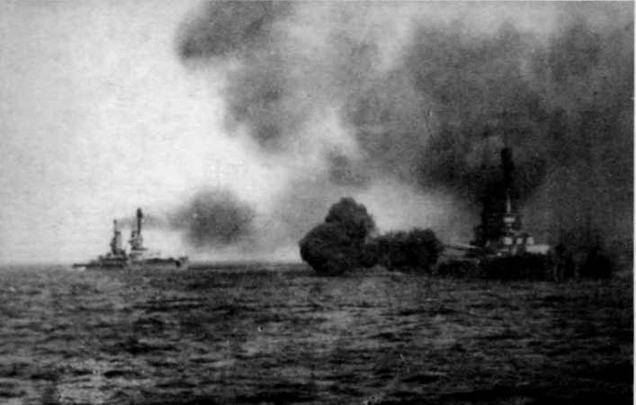
The linear ships at Moonsund. October 1917
Gulf of Riga
After the capture of the Svorbe peninsula, the route to the Gulf of Riga was opened. The only obstacle for the Germans remained minefields. Minesweepers to 16 October cleared the strait of mines. On the morning of this day, a detachment of German ships — the battleships König and Kronprinz, the light cruisers Kohlberg, Strasbourg and Augsburg, the destroyers 8 and the 20 semoflotilla, and also minesweepers and transports — Gulf of Riga. The detachment went to Ahrensburg, which was to become the main port of the expeditionary forces. The Germans were afraid of mines, so they moved slowly.
11 hours 30 min. The commander of the 3 squadron, Vice Admiral P. Benzke, received an order from Vice Admiral Schmidt to attack the Russian ships in Moonzund and the Gulf of Riga with all their might. This was supposed to speed up the implementation of the second phase of the operation. Vice Admiral Bentske decided to send a light cruiser Augsburg to Arensburg with transports and a part of minesweepers, and with the rest of the ships to go to the south entrance to Moonzund and stay there for the night to start fighting in the morning.
October 17 Admiral Schmidt began the second phase of the operation. He ordered to attack the base of the Russian fleet in Kuivast and destroy the Russian ships. This task was facilitated by the fact that the Germans acquired a map of minefields in the southern part of Moonzund. 3-I squadron of German battleships, having in front of a strong detachment of minesweepers and guarded by destroyers from submarines, was to attack Kuivast from the south, destroying along the way Russian fortifications and batteries on the islands of Werder and Mawn.
The first report of the appearance of enemy ships, Admiral Bakhirev, received from the destroyer Active, which was located south of the mine obstacle in Moonsund. Having got under attack of the opponent, our destroyer went to the north. The Germans set about trawling Russian mines at the southern entrance to Moonsund. The battleships Slava, Citizen (formerly Tsesarevich) and the armored cruiser Bayan on the orders of Vice-Admiral Mikhail Bakhirev set off towards enemy forces and opened fire on the minesweepers. "Glory" from a distance close to the limit, shelled the German battleships, covering minesweepers. "Citizen" and "Bayan" continued at this time shelling minesweepers. The German battleships responded, but their shots did not reach the position of "Glory". Glory has also never been hit, although some of its shells fell near the König. As a result, the Germans, seeing the inconvenience of their position in the narrowness that made it difficult to maneuver, retreated.
In 10 hours, the climax of the naval battle. "Glory", "Citizen" and "Bayan" headed south. Towards advanced enemy battleships. Started a shootout. "Citizen" for half an hour of battle received six hits, "Bayan" - three. Started strong fires. But most of all went to "Glory." “Konig” from the third volley covered the Russian battleship in three hits. The first shell hit the bow, piercing the armor under the waterline and exploding inside the bow of the dynamo, causing it, as well as the cellar of nasal 12-inch ammunition and other compartments in the nose, were flooded. The ship took 1 130 tons of water, got trim on the nose. The third projectile hit the left side armor belt opposite the engine room, but did not break through it. 10 hours 24 min. another two shells hit the ship, hitting the front chimney, they damaged the six-inch shell cellar and the front boiler room; a fire broke out that was put out. After some time, two more shells led to the flooding of the coal bunker. Around the same time, 6 of German hydroplanes attacked Russian ships and dropped 40 bombs, but none of them hit the target.
Bakhirev ordered the ships to depart the fairway in Moonsund. The battleship "Glory" had to go last out of fear that it could sink and close the rest of the escape route. However, the flow in the holds of "Glory" increased so much that the ship could not leave along with the rest of the fleet through the Strait of Moonsund. Then the admiral ordered the battleship to be flooded across the fairway, blocking the enemy’s way north. Soon the ship lay on the pitfalls to the south-east of the entrance to the strait. The destroyers removed the crew from the ship, after which around 12 hours the cellar of the aft 12-inch turret was blown up. The explosion was considered insufficiently strong, so three destroyers were ordered to finish off the ship with torpedoes. After hitting one of the six torpedoes fired at the Glory, the ship lay down on the ground with a hole in the port side in the chimney area. Despite the flooding of "Glory", the fairway was free. However, the Germans could not pursue the Russian ships because of the shallow water in the northern part of the strait.
The cruisers and minesweepers marching from 3 of the German squadron of battleships were turned to the north-west at the entrance to Moonsund and landed troops on Món Island for an assault from ground in the position of an artillery battery in the village of Voya. Cruisers fired at the Russian battery. 15 hours 45 min. landing landed. After a while, it was reported that the battery was taken without a fight. In the evening of the same day, the German destroyers entered the Moonzund from the side of the Kassar Reservoir. In 23 hours 20 min. the destroyer S-64 hit a mine near the island of Schildau. The damaged ship was blown up, and the remaining destroyers returned.
October 18 German troops continued to seize the islands of Móon and Dago, without encountering resistance. Around noon, the cruiser “Strasbourg” with destroyers and minesweepers, after a small skirmish with the Russian destroyers, took to the Kuivast raid. Then the battleships approached, and the ground forces completely captured Mawn.
The Russian command expected to continue the battle with the German fleet, but the crews of the two destroyer divisions refused to obey orders. As a result, on October 18, in order to prevent the German squadron from breaking through, several transport vessels were flooded on the orders of Admiral Bakhirev in the Moonsund Strait. Along the way, part of the garrisons of the islands of Món and Dago were evacuated. Most of the Russian island garrison was captured.
To cover the retreat of Russian ships from Moonzund the Gulf of Finland, the German command sent to the north of Dago 4-th squadron of battleships (without the "Kaiser»), 2-th Intelligence Group, 6-th fleet and 13-th poluflotiliyu destroyers with trawlers. The submarines were supposed to place mines on both sides of the island of Worms on possible escape routes of the Russian fleet. Having placed mines, the submarines were to remain in the area and wait for the Russian ships. But on October 19, the command canceled the operation of the 4 th battleship squadron, as minesweepers could not free the battleships from the strong storm. This allowed the Russian ships to retreat. Bakhireva's squadron waited for the storm near Worm Island, but after learning about the enemy’s plan, the Russians began trawling. The mines set by the German submarine were cleared, and in the morning of October 20, Russian ships arrived at Lapvik.
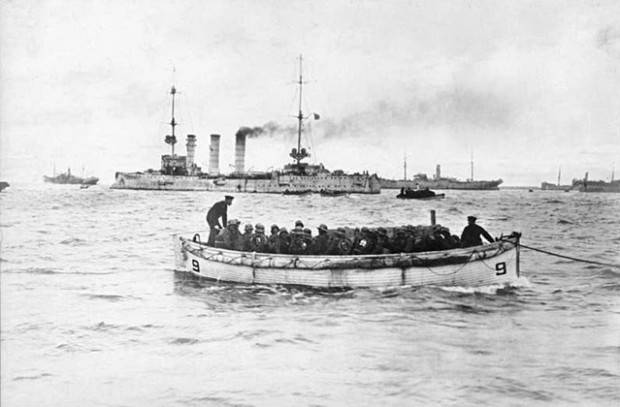
The landing of the German troops
Results
German armed forces seized the Moonsund archipelago and secured dominance in the Baltic. Russian armed forces suffered another serious defeat. The battle cost the Germans 9 sunk ships and damage even more (including the 3 battleship). At the same time, the Russian fleet lost two ships sunk (the destroyer "Thunder" and the battleship Glory ") and a number of damaged.
The losses of the German assault were insignificant and amounted to about 400 people killed, wounded and missing. Russian casualties by prisoners amounted to 20 130 people, the losses killed and wounded were relatively small. The Germans captured large trophies - 141 gun, 130 machine guns, 10 aircraft, a huge number of different stocks.
These were the last battles of the German fleet in the Baltic Sea in 1917. 7 December 1917, Russia and Germany signed a truce.
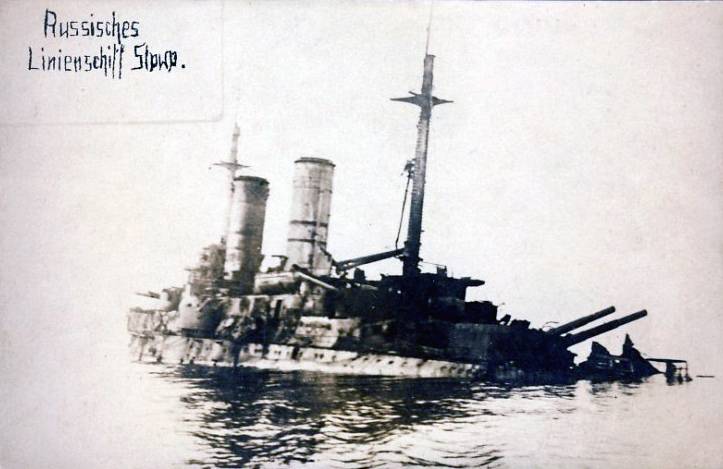
Blown battleship "Glory", lying on the ground. German Postcard
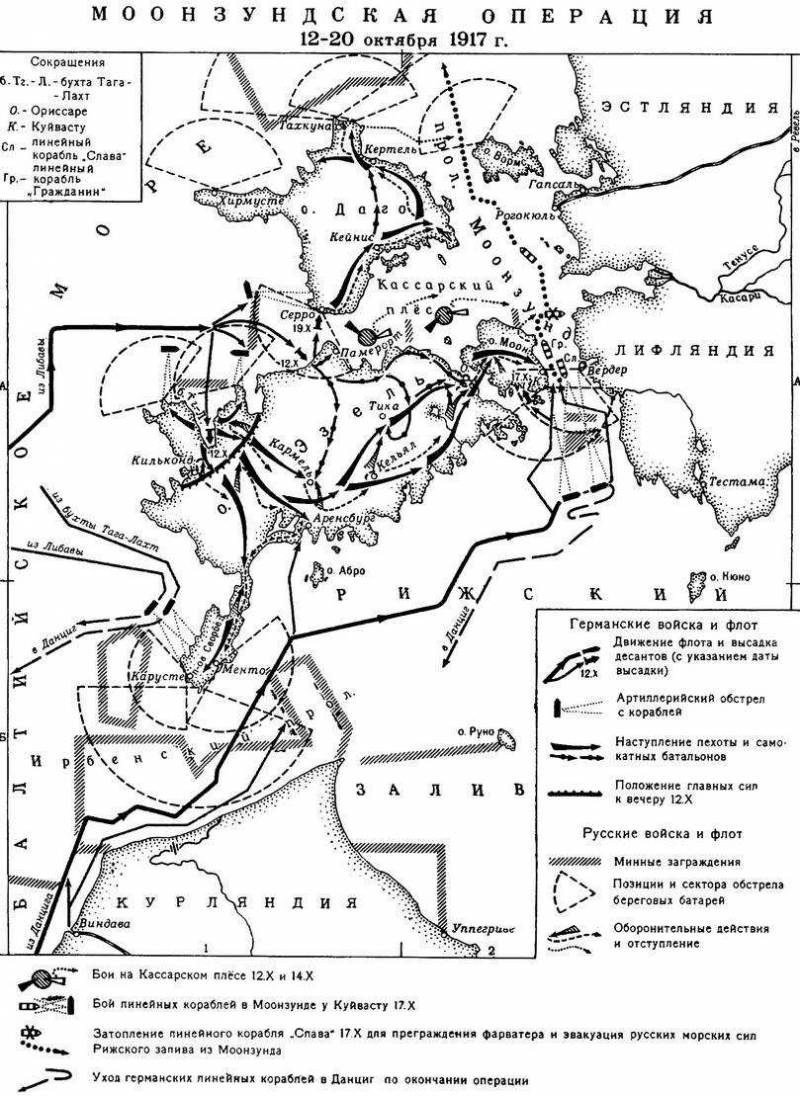
Information